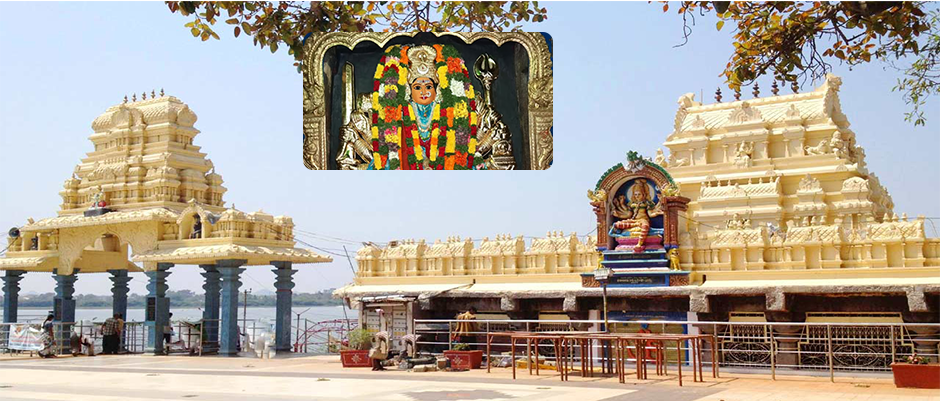
Bhadrakali Temple Warangal
Bhadrakali Temple, Warangal: A Timeless Abode of the Divine Mother
Nestled on a hill between the twin cities of Warangal and Hanamkonda, Bhadrakali Temple is a revered symbol of Shakti, radiating spiritual energy and grace. Dedicated to Goddess Bhadrakali, this revered shrine is among the most ancient temples in India, believed to have been originally established during the Chalukya dynasty in 625 AD.
A Temple Steeped in Devotion and History
Positioned along the serene banks of Bhadrakali Lake, the temple provides a soothing spiritual escape, embraced by the natural stillness all around. After centuries of relative obscurity, the temple was lovingly restored in the 1950s by Sri Ganapathi Sastri and devoted local supporters. Thanks to their efforts, the temple once again draws thousands of devotees every year, radiating divine energy and cultural pride.
Though the temple has undergone renovations, the remnants of its ancient architecture—especially the pillars near the sanctum—continue to whisper stories from its glorious past.
Goddess Bhadrakali: The Divine Warrior Mother
The presiding deity, Goddess Bhadrakali, is depicted in a seated posture, exuding a calm yet powerful aura. The central idol, carved from stone, measures around 2.7 meters in height. Depicted with eight arms carrying symbolic weapons, the Goddess exudes both power and serenity, crowned beautifully to reflect her divine status. Facing the sanctum is a lion statue, the vahana (vehicle) of the Goddess, symbolizing fearlessness and righteousness.
Spiritual Significance and Sacred Surroundings
While the Goddess is venerated as Bhadrakali, many believe the energy of the deity has been spiritually elevated through mantras to embody Tripura Sundari—the divine embodiment of beauty, grace, and supreme cosmic power across the three realms.
The Bhadrakali Lake, which was constructed during the Kakatiya era, not only supported irrigation but also contributed to the spiritual atmosphere. Spread over 2.5 km, the lake, bordered by hills and rock formations, offers a tranquil setting ideal for meditation and devotion.
A Legacy of Contributions
Built in classic Chalukyan style, the temple reflects the region’s ancient heritage and is believed to mark their victory over the Vengi territory. Later, the Kakatiya rulers, who worshipped Bhadrakali as their royal deity, enhanced the temple’s prominence. They also constructed the adjoining lake and contributed immensely to the temple’s development.
Following centuries of decline after the fall of the Kakatiyas, the temple was brought back to life in the 20th century. Sri Ganapathi Sastri, who moved from Karnataka in the 1940s, chose to settle near the temple ruins and took the initiative to restore the shrine. He was supported by other devout individuals like Sri Mudumbai Ramanujacharya, Sri Maganlal Sameja, and several others whose names are etched in the temple's revival history.
As part of the restoration, animal sacrifices were discontinued, and the deity’s form was softened—from a fierce warlike aspect to a more compassionate and serene expression. During restoration, sacred mantras were symbolically etched onto the tongue of the Goddess, infusing the sanctum with a deeper sense of divine vibration.
Daily Worship and Rituals
Today, the temple follows traditional Vedic rituals, and worship is conducted daily by dedicated priests. The sanctum and surrounding shrines, including those dedicated to Lord Shiva, Subramanya Swamy, Hanuman, and Navagrahas, are regularly visited by devotees.
A newer shrine to Lord Vigneshwara stands outside the main temple complex, adding to the spiritual vibrancy of the area.
Festivals and Celebrations
In the months of April or May, the temple comes alive with the Brahmotsavam festivities, drawing scores of devotees and resonating with divine celebrations. During Shravana Masa (August–September), festivals such as Vasanta Navaratri, Shakambari Utsavam, and Sharan Navaratri are joyfully observed. The Bathukamma Festival, marked by floral offerings from women and girls, is celebrated with devotion by the lake.
The temple grounds come alive with lamps, music, and a sea of devotees seeking blessings and spiritual solace.
Nearby Attractions
Just 2 km away, one can visit the renowned Thousand Pillar Temple, making it easy to combine both visits in a single spiritual journey. Other nearby temples such as Padmakshi Temple, Shirdi Sai Baba Temple, and Sri Narasimha Swamy Temple also offer rich devotional experiences.
Darshan Timings
The temple opens daily at 05:30 AM. Morning Darshan is available from 05:30 AM to 01:00 PM, and Evening Darshan from 03:00 PM to 08:30 PM, Monday to Sunday.
